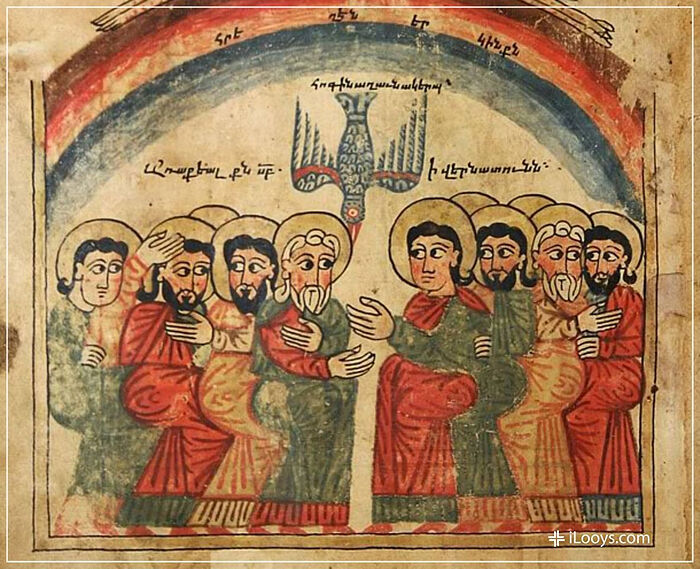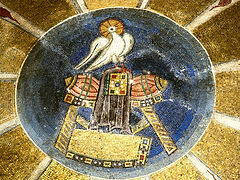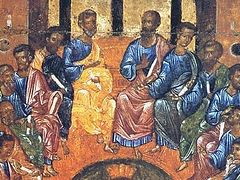It can be said that the day of Pentecost is the fulfillment of the entirety of sacred history, beginning from the creation of the world.
The whole of the Old Testament points and strives ahead to the God-Man Jesus Christ and that which is inseparable from Him—His Body, the Church.
Of course, the heart of God’s economy for our salvation and the center of all of history is the Crucifixion and Resurrection of Christ. “Through the Cross joy hath come into all the world.” And after remaining with His Disciples for forty days, the Risen Christ returns to Heaven, thus seating human nature at the right hand of God.
In Scripture, the number forty indicates a time of trial and testing. Thus, by remaining with the Disciples throughout these forty days, He signifies, as the Venerable Bede teaches, that He will be with us always, even unto the ages of ages, as He promised.
And ten days after Christ’s Ascension into Heaven, the Holy Spirit descends upon the Disciples, thus inaugurating the fullness of the Church on Earth. Through the Holy Spirit’s working in the Church, Christ’s presence is continued on Earth.
On the first day of creation, the Spirit was hovering upon the waters, brooding over them to bring forth life (which then occurred on the fifth day of creation) as a mother hen over her eggs. And in the very next verse, God says, Let there be light (Gen. 1:3).
Likewise, Christ resurrected while it was yet dark—He is the light that shines in the darkness. And on the day of Pentecost, the Holy Spirit descends as fire upon the Disciples, who up to that point were yet in the darkness of the fallen condition. But now, with the indwelling of the Holy Spirit, they are empowered to go out and bring this light to the entirety of the world, which wallows in darkness.
Christ was baptized and then went to cleanse the Temple. As His Body, the Church recapitulates His life, and the Holy Spirit comes to baptize the Disciples, thereby cleansing God’s true temple (1 Cor. 6:19-20).
In Deuteronomy 18, God promises to raise up a Prophet like unto Moses, and as Christians we know that this Prophet was to be the Lord Jesus Christ.
In Exodus 33, God tells Moses that He will hide him in the cleft of a rock and cover him with His hand. Then God will take away His hand and Moses will see the glory of God. That is, he is hidden in the earth and then brought out again—a type of death and resurrection unto new life.
In the next chapter, Moses is commanded to ascend Mt. Sinai, where he remains for forty days, receiving the commandments of the Law. And after the forty days, Moses’ face is seen to be shining with glory such that the people cannot bear to draw near or gaze upon him. He then gathers all the children of Israel and begins to preach to them the precepts of the Law that he had learned from the Lord.
Likewise, Christ remains with the Apostles for forty days, then ascends back to His Father, after which the Holy Spirit descends. The Apostles are filled with the glory of God, and as the men of old marveled at the sight of Moses, so the men of Jerusalem marvel at the Apostles on the day of Pentecost (Acts 2:7). The Apostles then go out to preach the precepts of the Gospel to the world.
St. Peter’s preaching on the day of Pentecost itself causes 3,000 men to convert and be baptized—to spiritually die and rise again—an inverse of the 3,000 Israelites who were slaughtered when Moses found them worshiping the golden calf (Ex. 32).
It can be generally said that the Mosaic Law dictates what to do and what not to do. However, in the Beatitudes, Christ spoke on a deeper level, of how to be and how not to be—He revealed, to a degree, the inner life of God. And with the indwelling of the Holy Spirit that began on the day of Pentecost, men are again made capable of living that life of God.
Upon giving Moses the tablets of the Law, the Lord makes a covenant with the Israelites, promising to drive the Amorites, Canaanites, Hittites, and other peoples out of the Promised Land and calling upon the Israelites to reject and destroy the idols of those peoples (Ex. 34:11-13).
Likewise, the Apostles go out to conquer the whole of the world, destroying its idols through the victory of the Gospel and turning it into the Promised Land through the presence of Christ in His Church.
The conquest of the Old Testament Promised Land begins under Joshua, the Son of Nun, who is called to lead Israel in the conquest of Canaan after the death of Moses. Likewise, Christ dies (though, of course, He rises again), and the Holy Spirit comes to lead the New Israel in spiritual conquest.
In Joshua 3-6, Israel enters the Promised Land by crossing the River Jordan, after which they are commanded to be circumcised again—both events are types of Baptism. On the day of Pentecost, the Apostles enter the Promised Land of the Church by receiving the Baptism of the Holy Spirit.
After they are circumcised, the children of Israel keep the Passover. Likewise, after their hearts are circumcised on Pentecost, the members of the Church continued steadfastly … in the breaking of bread (Acts 2:42)—in the celebration of the Eucharist.
The main city of Jericho falls through the people’s shouts and the blasts of their trumpets, while the main city of Jerusalem “falls” by the heralding of the holy Gospel of Christ. The conquest of Jericho was a sign of the further conquest of the land; the salvation of many in Jerusalem was a sign of the salvation of the whole world.




